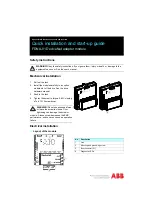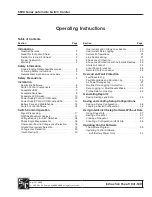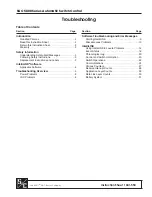
41
…4.11
Set Up Alarms Page
4
CONFIGURATION…
trIP
––––
– – –
YES
MOrE
HYSt
– – – –
More
alarms
no
Trip Level
Set the trip value required for the alarm selected above.
The following are displayed in engineering units:
HPrC
,
LPrC
,
HdEV
and
LdEU
.
HdEV
and
LdEV
alarms have both positive and negative
trip points. Refer to Fig. 4.11.
The following are displayed as percentages:
HOUt
and
LOUt.
The following are displayed as a percentage of span per
hour between
±
0.5 and
±
500%:
FrtE
and
SrtE
.
The following are displayed as event numbers:
PEVt
(1 to 9) and
SEVt
(1 to 30).
If the
Alarm Type
is set to
MOdE
the displayed characters
are alpha, not numeric. The following codes are
selectable:
AUtO
–
Automatic
MANUAL
–
Manual
L–SPt
–
Local set point
r–SPt
–
Remote set point – only selectable if
Second set point type is Remote set
point
dSPt
–
Dual set point– only selectable if
Second set point type is Dual set point
PVFAIL
–
process variable failure
rSFAIL
–
Remote set point failure
PNFAIL
–
position feedback failure
INFAIL
–
any input failure
P–HOLd
–
alarm activated when program is on
Hold (Profile only)
If
AUtO
,
MANUAL
,
L–SPt
,
r–SPt
, or
d–SPt
is selected
and an attempt is made to use that facility (Automatic,
Manual, Local set point, Remote set point, or Dual set
point) the alarm is activated.
Hysteresis
The hysteresis is operational when the alarm is active.
Set the hysteresis value required (in engineering units),
between display full scale and zero, or percentage rate set
on rate alarms, in 0.1% increments. The alarm is activated
at the trip level but is only turned off after the alarm variable
has moved into the safe region by an amount equal to the
hysteresis value. Refer to Figs. 4.9 to 4.13.
More Alarms to be Programmed?
If there are, select
YES
otherwise select
no
.
Return to
Alarm Identities
frame, or advance to the next
parameter.
Continued on next page
Artisan Technology Group - Quality Instrumentation ... Guaranteed | (888) 88-SOURCE | www.artisantg.com















































